|
|
|
Sort Order |
|
|
|
Items / Page
|
|
|
|
|
|
|
| Srl | Item |
| 1 |
ID:
124696
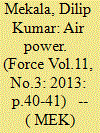

|
|
|
|
|
| Publication |
2013.
|
| Summary/Abstract |
At the 81st annual Raising Day parade of the Indian Air Force (IAF), amidst the celebrations, there was a hidden cautious note. In the words of Air Chief Marshal NAK Browne, who described the air assets as both "expensive and scarce", the primary resposibility would be the security of their equipment. "The safety and security of these (assets) is our prime responsibility. While ensuring their physical security is important, there is also an increasing need to ensure security of our vital communication and operational information networks," he said. Admittedly, the past year has been the most challenging for the IAF, and also the most rewarding.
|
|
|
|
|
|
|
|
|
|
|
|
|
|
|
|
| 2 |
ID:
124700
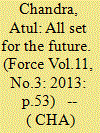

|
|
|
|
|
| Publication |
2013.
|
| Summary/Abstract |
The EADS Innovation Works site at Bangalore exists to prepare the future and explore the synergies for the group and is working on several important projects at present. Interacting with select media in Bangalore on his first visit to India after taking charge as Head of EADS Innovation Works in June this year, Sébastien Remy outlined his plans for the Bangalore centre, "We are focussing on the long term activities like the emerging technologies and solutions". He adds that the Bangalore centre is "working with Cassidian India to optimise performance of radars something that could be fully applicable to existing products. This on-going research work has resulted in the filing of a patent."
|
|
|
|
|
|
|
|
|
|
|
|
|
|
|
|
| 3 |
ID:
124682
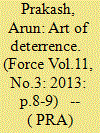

|
|
|
|
|
| Publication |
2013.
|
| Summary/Abstract |
That the chairman of the National Security Advisory Board (NSAB), Shyam Saran, has seen fit to provide reassurance about India's nuclear deterrent through the media (Indian Express 3 October 2013) is a long-overdue but very comforting gesture. While he rightly assails the sceptics who label India's nuclear deterrent as a measure of prestige rather than a security imperative, he spares the national-security establishment whose egregious silence over the past 15 years has allowed such doubts to take root and prosper.
It is true that a reduction of conventional forces, as many seem to expect, may not be an automatic consequence of the induction of nuclear weapons. However, it is also a fact that a nation's political and military postures as well as manner of conducting international relations must undergo substantive change on acquiring the status of a nuclear-weapon state (NWS). Not only has this not happened in India's case, but the structure of its conventional forces as well as their command & control systems and the pattern of its huge defence spending remain ad-hoc and haphazard; as if we are trapped in a debilitating time-warp.
|
|
|
|
|
|
|
|
|
|
|
|
|
|
|
|
| 4 |
ID:
124684
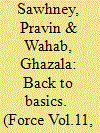

|
|
|
|
|
| Publication |
2013.
|
| Summary/Abstract |
When chief of army staff (COAS), General Bikram Singh took over as the head of the 13 lakh strong army on 31 May 2012, he was conscious of the extraordinary circumstances that had preceded his elevation. His predecessor, in his public fight with the government over his age row, had wittingly or unwittingly harmed the army grievously. The manpower, which is the real asset of any professional army, had been compelled to take sides: for or against the army chief, General V.K. Singh. Was their chief working for the army or simply for himself, was the question being discussed, in hushed voices, at all levels, from senior officers' enclaves, to formation and unit messes, junior commissioned officers (JCO) messes, and soldiers' langars. When the senior-most officer becomes suspect, the other officers could no longer remain above board.
|
|
|
|
|
|
|
|
|
|
|
|
|
|
|
|
| 5 |
ID:
124683
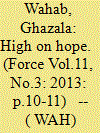

|
|
|
|
|
| Publication |
2013.
|
| Summary/Abstract |
On October 29, the largest paramilitary force in India, the Central Reserve Police Force (CRPF), ushered in its 75th year. A new logo was released by director general Dilip Trivedi on October 28 to mark the diamond jubilee of the force which has seen several incarnations, identity crises and re-orientation of roles in its chequered history. One would have expected a little more certainty at age 75, but all that DG Trivedi feels confident about is being "the lead force for internal security," and now the "nodal agency for force mobilisation for elections".
|
|
|
|
|
|
|
|
|
|
|
|
|
|
|
|
| 6 |
ID:
124697
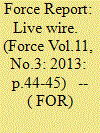

|
|
|
|
|
| Publication |
2013.
|
| Summary/Abstract |
After a long peace since the ceasefire came into being on 26 November 2003, the International Border (IB) in Jammu witnessed numerous ceasefire violations in 2013. Unlike the Line of Control (LC) which has seen innumerable ceasefire violations each year, with as many as 250 in 2013 alone, the IB getting live was unusual. The firings intensified since August causing loss of lives and property to civilians, who unlike the LC, live close to the IB. This unexpected activity got the Jammu and Kashmir chief minister, Omar Abdullah, to say that India should exercise options to silence Pakistani firing. Matters, however, finally settled on the IB with the recent meeting of the Border Security Force (BSF) and its counterpart, the Pakistani Chhamb rangers in R.S Pura sector. At sector commanders' level, both the sides agreed to maintain ceasefire and restore issues through negotiations.
|
|
|
|
|
|
|
|
|
|
|
|
|
|
|
|
| 7 |
ID:
124699
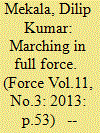

|
|
|
|
|
| Publication |
2013.
|
| Summary/Abstract |
On October 24, Indo-Tibetan Border Police (ITBP) celebrated its 52nd anniversary with a ceremonial parade at the Tigri campus, New Delhi. Looking back at the past year, ITBP can't seem to deny that this has been the most challenging year for their personnel. Starting with the incursions of the Chinese Army at the Line of Actual Control (LAC) in April, which led to the face-off between the Chinese and the Indian forces at the border, to the Uttarakhand flood rescue efforts, considered the biggest ever operation till date, the ITBP faced tough challenges this year. This was again followed by more incursions from the Chinese Army in the subsequent months.
But the good news is that the ITBP is getting a major push from the government to develop its infrastrusture both at the border and its various headquarters in the mainland. Speaking at the Raising Day parade, chief guest R.P.N. Singh, minister of state (Home) said that the government has sanctioned Rs 1,260 crore for construction on the ITBP locations. It includes accommodation for jawans, construction of forward locations and other operational and administrative buildings and structures. He also said that measuring eco-friendly stride towards energy requirement, a total of 69 forward ITBP posts would soon have three to 10 KVA solar power plants which will facilitate uninterrupted power supply for various needs.
|
|
|
|
|
|
|
|
|
|
|
|
|
|
|
|
| 8 |
ID:
124687


|
|
|
|
|
| Publication |
2013.
|
| Summary/Abstract |
Events on the Line of Control (LC) in the last few months should give a wake-up call to the serving top brass of the Indian Army on the need to introspect. It is worrisome that the army is seen losing its sheen and questions are being raised on its capability to dominate the LC. Apart from that, we need to ponder as to why the officer-man relationship is under strain, with so many incidents of fracas between officers and men in different units taking place and the famous Chetwood motto being discarded in the process
|
|
|
|
|
|
|
|
|
|
|
|
|
|
|
|
| 9 |
ID:
124680
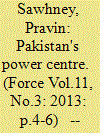

|
|
|
|
|
| Publication |
2013.
|
| Summary/Abstract |
In his years as COAS, General Ashfaq Pravez Kayani has by default done some good to the bilateral relationship.
|
|
|
|
|
|
|
|
|
|
|
|
|
|
|
|
| 10 |
ID:
124701
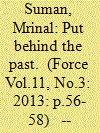

|
|
|
|
|
| Publication |
2013.
|
| Summary/Abstract |
On 18 September 2013, during his visit to India, US deputy secretary of defence Ashton B. Carter, the second highest ranking official of the Pentagon, made a momentous offer of technological cooperation to India. More significantly, he announced that the US was prepared to co-develop and co-manufacture products that could be sold internationally. It was a major policy statement that reflected a keen desire of the US to improve military ties with India. The offer took many Indian observers by surprise.
During the Cold War period, Indo-US military relations were either non-existent or lacked intensity. The US considered India to be in the Soviet camp and declined to sell any worthwhile military equipment to it. The collapse of the Soviet Union saw the end of the Cold War. Thereafter, protracted Indo-US engagement resulted in the 'Agreement on Defence Relations' in 1995.
|
|
|
|
|
|
|
|
|
|
|
|
|
|
|
|
| 11 |
ID:
124686
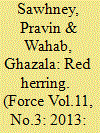

|
|
|
|
|
| Publication |
2013.
|
| Summary/Abstract |
It was making a mountain out of a molehill. Both the army and the media were complicit in this: One deliberately and the other out of ignorance. The recent anti-infiltration operations in Keran sector, which were declared over after two weeks on October 8 by the chief of army staff, General Bikram Singh in Delhi and the northern army commander, Lt General Sanjiv Chachra in Srinagar, were nothing more than a molehill.
Given such high profile army visitations, the media also decided to up the ante by searching for ghosts that did not exist. Did Pakistani soldiers intrude and occupy Indian posts across the Line of Control (LC)? Was another Kargil being replayed in Keran? Was the Indian Air Force using gunships to dislodge terrorists? Were recent talks between Prime Ministers Manmohan Singh and Nawaz Sharif in New York, which sought meetings between the two director general military operations (DGMOs), up in smoke? An English television channel (NDTV) even showed meeting with injured soldiers in Srinagar hospital as exclusive news.
|
|
|
|
|
|
|
|
|
|
|
|
|
|
|
|
| 12 |
ID:
124698


|
|
|
|
|
| Publication |
2013.
|
| Summary/Abstract |
As one enters the sprawling Suraksha Bhawan, the heart of the Border Security Force (BSF) Academy in Madhya Pradesh, an interesting story emerges about the architecture of the building. After World War I, Maharaja Jiwaji Rao Scindia, the ruler of Gwalior state, was invited as an observer to the signing of the Treaty of Versailles in France. During his visit to France, he happened to see a building shaped like an anchored ship with multi-layered decks. Extremely fascinated by the architecture of the building, he decided to construct a similar one in his kingdom, and use it for retreats and other recreational purposes. As soon as he returned to India, the search for land began and finally Tekanpur, a small village located 30 km from Gwalior, was zeroed in for this ambitious construction. To realise his dream, Scindia commissioned a Spanish architect to design the retreat. By joining two mountains, a massive embankment (a 1875 metres long and 17.7 metres high dam) was created for this purpose. On this embankment, Scindia's vision of a perfect recreational getaway came into existence in the Thirties.
|
|
|
|
|
|
|
|
|
|
|
|
|
|
|
|
| 13 |
ID:
124689
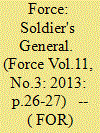

|
|
|
|
|
| Publication |
2013.
|
| Summary/Abstract |
Describing his first meeting with Hanut in July 1956, Lieutenant General Ajai Singh who later became a governor, has written in the book, Fakhr-e-Hind: The Story of the Poona Horse:
It was after two to three days of my stay in the Regiment that I met him. I was sitting in the C Squadron office after the Maintenance Parade when a tall, thin, smartly turned out officer entered the office. What struck me most about him was his prominent hooked nose and the very proud and penetrating look in his eyes. He walked to me and met with such enthusiasm, warmth and affection that I felt as though we had known each other for ages… Thereafter, without further ado, he took me to the Squadron and introduced me to all members of his troop, which I was to take over. Having done this at the garages itself, he gave me a programme for my training which I was to commence from the next day; he also gave me a large bundle of books and précis which I was to read in my own time. I went through all this businesslike activity in a state of total shock because, till then, such a serious approach to professional matters had neither been seen nor heard during the few days I had spent in the Regiment.
|
|
|
|
|
|
|
|
|
|
|
|
|
|
|
|
| 14 |
ID:
124694


|
|
|
|
|
| Publication |
2013.
|
| Summary/Abstract |
Training the next generation of Air Warriors is an onerous responsibility at Air Force Academy (AFA), Dundigal, and one taken very seriously by the instructors here. No detail is too small and nothing is overlooked, as the experienced instructors watch over their rookie flight cadets like hawks. As a military aviator, one requires a lifetime dedication to flying and taking to the air is a matter that one simply cannot take lightly
|
|
|
|
|
|
|
|
|
|
|
|
|
|
|
|
| 15 |
ID:
124690
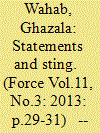

|
|
|
|
|
| Publication |
2013.
|
| Summary/Abstract |
That as a nation we are obsessed with ground-based tactics was in ample evidence at the annual press conference of the chief of air staff (CAS) Air Chief Marshal NAK Browne. A week before the 81st Indian Air Force day celebrations, the CAS and his staff had probably burnt the midnight oil to take on some hard-hitting questions from the media on the receding possibility of signing the ambitious Rafale fighter deal; depleting force levels; poor state of Indian Air Force (IAF) ground infrastructure, especially in remote border areas; allegations of nepotism on certain contracts and corruption on others; slow pace of modernisation of air defence assets; IAF's obstinacy on reforms in higher defence management; and inadequacy of ideas on creating a cogent deterrence for the threat from the east. Not once during their midnight confabulations would they have imagined, that all these efforts would come to a nought.
Because very few in the assembled gathering of the journalists wanted to ask the air force chief any question on the air force. Everyone wanted to know - repeatedly, question after question, in various combinations and permutations - about Indian Army's counter-infiltration (CI) operation in the Keran sector of north-west Kashmir. Kindled by exaggerations and fanned by rumours, the so-called CI operation in the thick forests of Keran was likened to the occupation of the Indian Army posts in the Kargil sector (northeast Kashmir), nearly 14 years ago. Even senior journalists, some with over 30 years of experience covering the Indian military, had started to write that a repeat of Kargil was underway with the Pakistan Army's irregulars having occupied the Indian territory.
|
|
|
|
|
|
|
|
|
|
|
|
|
|
|
|
| 16 |
ID:
124692


|
|
|
|
|
| Publication |
2013.
|
| Summary/Abstract |
When one enters the main gate at Air Force Academy (AFA) Dundigal, there is little indication of the winds of change blowing through the Indian Air Force's (IAF) premier training establishment. Only when one nears the flight hangars, does the constant drone of aircraft engines give an indication of the high level of flying activity at the base. At AFA the sight and sound of the IAF's newest Basic Trainer Aircraft (BTA), the Swiss Pilatus PC-7 MK-II taking off and landing at regular intervals, symbolises the end of a particularly trying period for basic training of rookie flight cadets within the IAF.
|
|
|
|
|
|
|
|
|
|
|
|
|
|
|
|
|
|
|
|
|